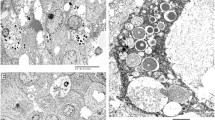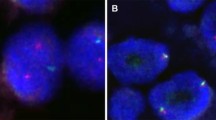Abstract
Mammary analogue secretory carcinoma (MASC) has a specific ETV6-NTRK3 translocation and morphologically overlaps with acinic cell carcinoma (AciCC). Before the recognition of MASC, in AciCC, four histologic patterns were identified including microcystic, solid, papillary-cystic, and follicular. The aim of this study was to evaluate histologic patterns in these two neoplasms through comprehensive histologic subtyping. Using fluorescence in situ hybridization (FISH), we identified 14 cases of MASC and 21 cases of AciCC. We used comprehensive histologic subtyping to provide a semiquantitive assessment of histologic patterns in each tumor and performed immunohistochemical analyses including S100/vimentin/mammaglobin/DOG1. MASC often presented papillary-cystic patterns without a solid component, previously considered to be one of the four major patterns associated with AciCC. However, in our study, this histologic feature was rarely seen in AciCC and more characteristic of MASC. In aspiration cytology samples, MASC was associated with more cellular atypia. An immunohistochemical panel of S100/mammaglobin/DOG1 was found useful for differential diagnosis. Comprehensive subtyping of histologic patterns is a useful screening method prior to initiation of molecular testing.




Similar content being viewed by others
References
Skálová A, Vanecek T, Sima R, Laco J, Weinreb I, Perez-Ordonez B, Starek I, Geierova M, Simpson RH, Passador-Santos F, Ryska A, Leivo I, Kinkor Z, Michal M (2010) Mammary analogue secretory carcinoma of salivary glands, containing the ETV6-NTRK3 fusion gene: a hitherto undescribed salivary gland tumor entity. Am J Surg Pathol 34:599–608. doi:10.1097/PAS.0b013e3181d9efcc
Lannon CL, Sorensen PH (2005) ETV6-NTRK3: a chimeric protein tyrosine kinase with transformation activity in multiple cell lineages. Semin Cancer Biol 15:215–223
Connor A, Perez-Ordoñez B, Shago M, Skálová A, Weinreb I (2012) Mammary analog secretory carcinoma of salivary gland origin with the ETV6 gene rearrangement by FISH: expanded morphologic and immunohistochemical spectrum of a recently described entity. Am J Surg Pathol 36:27–34. doi:10.1097/PAS.0b013e318231542a
Ellis G, Simpson RHW (2005) Acinic cell carcinoma. In: Barnes L, Eveson JW, Reichart P, Sidransky D (eds) World health organization classification of tumours. Pathology & Genetics of Head and Neck Tumours. IARC press, Lyon, pp 216–218
Chiosea SI, Griffith C, Assaad A, Seethala RR (2012) The profile of acinic cell carcinoma after recognition of mammary analog secretory carcinoma. Am J Surg Pathol 36:343–350. doi:10.1097/PAS.0b013e318242a5b0
Bishop JA (2013) Unmasking MASC: bringing to light the unique morphologic, immunohistochemical and genetic features of the newly recognized mammary analogue secretory carcinoma of salivary glands. Head Neck Pathol 7:35–39. doi:10.1007/s12105-013-0429-0
Jung MJ, Song JS, Kim SY, Nam SY, Roh JL, Choi SH, Kim SB, Cho KJ (2013) Finding and characterizing mammary analogue secretory carcinoma of the salivary gland. Korean J Pathol 47:36–43. doi:10.4132/KoreanJPathol.2013.47.1.36
Chiosea SI, Griffith C, Assaad A, Seethala RR (2012) Clinicopathological characterization of mammary analogue secretory carcinoma of salivary glands. Histopathology 61:387–394. doi:10.1111/j.1365-2559.2012.04232.x
Stenman G (2013) Fusion oncogenes in salivary gland tumors: molecular and clinical consequences. Head Neck Pathol 7(Suppl 1):12–19. doi:10.1007/s12105-013-0462-z
Skálová A (2013) Mammary analogue secretory carcinoma of salivary gland origin: an update and expanded morphologic and immunohistochemical spectrum of recently described entity. Head Neck Pathol (Suppl 1): 30-36. doi: 10.1007/s12105-013-0455-y
Bishop JA, Yonescu R, Batista D, Begum S, Eisele DW, Westra WH (2013) Utility of mammaglobin immunohistochemistry as a proxy marker for the ETV6-NTRK3 translocation in the diagnosis of salivary mammary analogue secretory carcinoma. Hum Pathol 44:1982–1988. doi:10.1016/j.humpath.2013.03.017
Chênevert J, Duvvuri U, Chiosea S, Dacic S, Cieply K, Kim J, Shiwarski D, Seethala RR (2012) DOG1: a novel marker of salivary acinar and intercalated duct differentiation. Mod Pathol 25:919–929. doi:10.1038/modpathol.2012.57
Urano M, Nagao T, Miyabe S, Ishibashi K, Higuchi K, Kuroda M (2015) Characterization of mammary analogue secretory carcinoma of the salivary gland: discrimination from its mimics by the presence of the ETV6-NTRK3 translocation and novel surrogate markers. Hum Pathol 46:94–103. doi:10.1016/j.humpath.2014.09.012
Simpson RH, Skálová A, Di Palma S, Leivo I (2014) Recent advances in the diagnostic pathology of salivary carcinomas. Virchows Arch 465:371–384. doi:10.1007/s00428-014-1639-x
Nordkvist A, Mark J, Gustafsson H, Bang G, Stenman G (1994) Non-random chromosome rearrangements in adenoid cystic carcinoma of the salivary glands. Genes, Chromosomes Cancer 10:115–121
Nordkvist A, Gustafsson H, Juberg-Ode M, Stenman G (1994) Recurrent rearrangements of 11q14-22 in mucoepidermoid carcinoma. Cancer Genet Cytogenet 74:77–83
Brill LB 2nd, Kanner WA, Fehr A, Andrén Y, Moskaluk CA, Löning T, Stenman G, Frierson HF Jr (2011) Analysis of MYB expression and MYB-NFIB gene fusions in adenoid cystic carcinoma and other salivary neoplasms. Mod Pathol 24:1169–1176. doi:10.1038/modpathol.2011.86
Persson M, Andrén Y, Moskaluk CA, Frierson HF Jr, Cooke SL, Futreal PA, Kling T, Nelander S, Nordkvist A, Persson F, Stenman G (2012) Clinically significant copy number alterations and complex rearrangements of MYB and NFIB in head and neck adenoid cystic carcinoma. Genes, Chromosomes Cancer 51:805–817. doi:10.1002/gcc.21965
Fehr A, Stenman G, Bullerdiek J, Löning T (2009) Molecular markers in salivary gland tumors: their use in diagnostic and prognostic workup. Pathologe 30:466–471. doi:10.1007/s00292-009-1206-4
Zhou MH, Gao L, Jing Y, Xu YY, Ding Y, Wang N, Wang W, Li MY, Han XP, Sun JZ, Wang LL, Yu L (2012) Detection of ETV6 gene rearrangements in adult acute lymphoblastic leukemia. Ann Hematol 91:1235–1243. doi:10.1007/s00277-012-1431-4
Patel KR, Solomon IH, El-Mofty SK, Lewis JS Jr, Chernock RD (2013) Mammaglobin and S-100 immunoreactivity in salivary gland carcinomas other than mammary analogue secretory carcinoma. Hum Pathol 44:2501–2508. doi:10.1016/j.humpath.2013.06.010
Bishop JA, Yonescu R, Batista D, Eisele DW, Westra WH (2013) Most nonparotid "acinic cell carcinomas" represent mammary analog secretory carcinomas. Am J Surg Pathol 37:1053–1057. doi:10.1097/PAS.0b013e3182841554
Chan JK (2013) Newly available antibodies with practical applications in surgical pathology. Int J Surg Pathol 21:553–572. doi:10.1177/1066896913507601
Skálová A, Vanecek T, Majewska H, Laco J, Grossmann P, Simpson RH, Hauer L, Andrle P, Hosticka L, Branžovský J, Michal M (2014) Mammary analogue secretory carcinoma of salivary glands with high-grade transformation: report of 3 cases with the ETV6-NTRK3 gene fusion and analysis of TP53, β-catenin, EGFR, and CCND1 genes. Am J Surg Pathol 38:23–33. doi:10.1097/PAS.0000000000000088
Acknowledgments
The authors would like to thank Ms. Syue-Fong Hua for her technical support and the Department of Pathology at the National Taiwan University Hospital for providing laboratory facilities. This study was supported by grants from the National Taiwan University Hospital (103-002523) and the Far East Memorial Hospital (FEMH 2014-C-052).
Conflict of interests
All authors have no potential conflict of interest to declare.
Author information
Authors and Affiliations
Corresponding author
Rights and permissions
About this article
Cite this article
Hsieh, MS., Chou, YH., Yeh, SJ. et al. Papillary-cystic pattern is characteristic in mammary analogue secretory carcinomas but is rarely observed in acinic cell carcinomas of the salivary gland. Virchows Arch 467, 145–153 (2015). https://doi.org/10.1007/s00428-015-1786-8
Received:
Revised:
Accepted:
Published:
Issue Date:
DOI: https://doi.org/10.1007/s00428-015-1786-8




